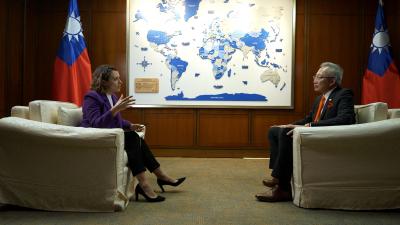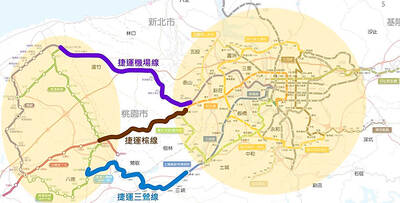Just two months after massive protests shut down Thailand’s international airport in Bangkok and stranded thousands of tourists, long lines of international visitors, with many arriving from faraway places such as Europe, the US and the Middle East, crowd the Suvarnabhumi Airport.
They come for Thailand’s sun, beaches, culture and perhaps most importantly the warmth of its people and its tourist-friendly environment.
Despite the economic downturn and political turmoil, “what is strong in Thailand remains strong and even stronger ... The strongest [point] are Thai people themselves,” said Tharit Charungvat, director-general of the Department of Information.
As Taiwan tries to boost the number of tourists who visit, nearby Thailand can serve as a role model that has succeeded in building a strong tourism industry, and one that is able to attract tourists for repeat visits, Taiwan’s representative to the Southeast Asian country said.
In an interview, Roy Wu (烏元彥) praised the friendly service in Thailand, from which he said Taiwan’s service industry could learn a lot.
He said that during the closure of Suvarnabhumi Airport amid protests against the government in late November, the Thai authority sent artists to the airport to perform for foreign tourists trapped there.
Moreover, vendors near the airport offered them free beverages and food.
“The Thai government and its people are very attentive [to foreign visitors],” Wu said.
‘TOUR TAIWAN YEAR’
In contrast, few Western tourists are normally seen at the Taiwan Taoyuan International Airport in Taipei.
In the hope of boosting tourism as a key industry, especially as manufacturing companies have moved to developing countries such as China and Vietnam in recent years, Taiwan’s government has designated last year and this year as “Tour Taiwan Years.”
It is offering a series of incentives, including free subway passes, tickets to hot spring resorts and chances to win large amounts of money to lure visitors to Taiwan.
Last year, Taiwan received 3.85 million visitors, an increase of 3 percent compared to 2007, among whom 46.2 percent were tourists and 22.9 percent were business travelers, the Tourism Bureau said.
The bureau hopes the number of tourists will reach at least 4 million this year.
At the same time, one of Asia’s top tourist destinations — Thailand — estimated optimistically that their country received approximately the same number of tourists last year as in 2007, around 14.5 million, despite the economic downturn.
Taiwan and Thailand’s tourism resources and strategies, however, are different.
While Thailand is blessed with many white sand beaches and a tropical climate, Taiwan’s coasts are mostly rocky and the weather is not as warm.
Taiwan, however, has rich natural beauty — including one of the tallest mountain in northeast Asia — Yushan — scenic coastal areas and rich local culture.
The challenges Taiwan faces, however, are in providing easy access to its tourism resources. Many of the mountains, for instance, are not easily accessible for individual climbers. Climbers are therefore advised to join mountain climbing tours.
PACKAGE TOURS
Many of the tourists coming to Taiwan are on package tours; but the Tourism Bureau hopes to attract more individual travelers.
To do so, signs must be clearly marked in English, routes and directions must be clear and the English-speaking ability of residents must improve.
The cost of hotels, food and travel in Taiwan also tends to be higher than that of Thailand, while the quality is not necessarily better.
In the hope of boosting tourism and helping the flagging economy, the Legislative Yuan this month passed a bill to allow casinos to be developed as part of resorts on outlying islands.
Thailand, a heavily Buddhist country, meanwhile, frowns on going down that route.
The law has sparked controversy, with opposition from religious groups and doubt as to whether the casinos would really boost economic development and tourism.
Santichai Euachongprasit, deputy governor for international marketing of the Tourism Authority of Thailand (TAT), said that while Thai people at one point debated whether to allow casinos in their country, in the end they strongly opposed it. The country will not consider casinos as a way to promote tourism, he said.
“We offer other tourist attractions such as beaches and cultural attractions, which are more than enough,” he said. “Casinos often open in a country or a destination where they do not have many natural or cultural attractions, like [in a] desert or [small] cities,” the tourism official said.
And the country’s tourism statistics have proven that focusing on preserving and protecting one’s natural resources works.
“We have 61 percent repeat visitors,” Santichai said. “Thailand can offer a wide range of things to do; one visit is not enough ... and our price is very affordable.”
While Thailand leaves its nature and tourism spots largely untouched by development and hotels and resorts are built in a tasteful fashion that largely blends in with nature, Taiwan has made the mistake of allowing many non-descript, unattractive buildings mar its natural scenery.
A huge hotel, for example, has been approved for the banks of one of its most picturesque attractions — Sun Moon Lake — which local residents and tourists already say has too many smaller hotels obstructing views.
UNIQUE
However, Liu Hsi-lin (劉喜臨), director of the Tourism Bureau’s International Affairs Division, said in a recent interview that Taiwan has its own strategy.
Future casinos located on outlying islands will be only one of the attractions in the whole tourism business.
Taiwan is also trying to present its unique characteristics to compete with other countries in Asia, he said.
To attract European and US tourists, Liu said his agency aimed to promote tours with specific teams that feature Taiwan’s rich natural and cultural resources, such as bird-watching tours, mountain-climbing tours and a tours focusing on the National Palace Museum’s collection of the best treasures of Chinese civilization.

“China is preparing to invade Taiwan,” Deputy Minister of Foreign Affairs Francois Wu (吳志中) said in an exclusive interview with British media channel Sky News for a special report titled, “Is Taiwan ready for a Chinese invasion?” the Ministry of Foreign Affairs said today in a statement. The 25-minute-long special report by Helen Ann-Smith released yesterday saw Sky News travel to Penghu, Taoyuan and Taipei to discuss the possibility of a Chinese invasion and how Taiwan is preparing for an attack. The film observed emergency response drills, interviewed baseball fans at the Taipei Dome on their views of US President

The Central Weather Administration (CWA) today issued a "tsunami watch" alert after a magnitude 8.7 earthquake struck off the Kamchatka Peninsula in northeastern Russia earlier in the morning. The quake struck off the east coast of the Kamchatka Peninsula at 7:25am (Taiwan time) at a depth of about 19km, the CWA said, citing figures from the Pacific Tsunami Warning Center. The CWA's Seismological Center said preliminary assessments indicate that a tsunami could reach Taiwan's coastal areas by 1:18pm today. The CWA urged residents along the coast to stay alert and take necessary precautions as waves as high as 1m could hit the southeastern

ECONOMIC BENEFITS: The imports from Belize would replace those from Honduras, whose shrimp exports have dropped 67 percent since cutting ties in 2023 Maintaining ties with Taiwan has economic benefits, Ministry of Foreign Affairs officials said yesterday, citing the approval of frozen whiteleg shrimp imports from Belize by the Food and Drug Administration (FDA) as an example. The FDA on Wednesday approved the tariff-free imports from Belize after the whiteleg shrimp passed the Systematic Inspection of Imported Food, which would continue to boost mutual trade, the ministry said. Taiwan’s annual consumption of whiteleg shrimps stands at 30,000 tonnes, far exceeding domestic production, the ministry said. Taiwan used to fill the gap by importing shrimps from Honduras, but purchases slumped after Tegucigalpa severed diplomatic ties with Taiwan

The Executive Yuan yesterday approved a southwestern extension of the Sanying MRT Line from New Taipei to Bade District (八德) in Taoyuan, with a goal of starting construction by late 2026. The 4.03-kilometer extension, featuring three new stations, will run from the current terminus at Yingtao Fude Station (LB12) in New Taipei City to Dannan Station (LB14), where it will connect with Taoyuan’s Green Line, New Taipei City Metro Corp said in a statement. This extension will follow the completion of core Sanying Line, a 14.29-kilometer medium-capacity system linking Tucheng (土城), Sansia (三峽)